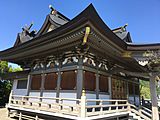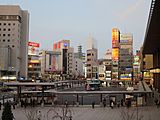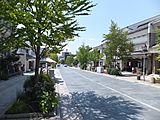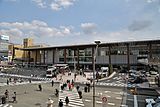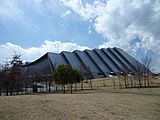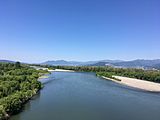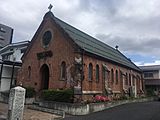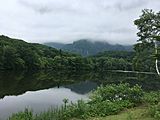Nagano (city) facts for kids
Quick facts for kids
Nagano
長野市
|
|||||||||||
|---|---|---|---|---|---|---|---|---|---|---|---|
![From top of left, Zenkoji, Mount Togakushi, Kinasa village, Nagano Big Hat arena, Aerial in Kawanakajima, Susobana Valley [ja], headquarters of Marukome (famous miso manufacturing company) in Nagano, Oyaki Japanese sweets a.k.a Imagawayaki, Togakushi ski resort [ja], and Matsushiro Castle](/images/thumb/7/79/Nagano_montages.JPG/300px-Nagano_montages.JPG)
From top of left, Zenkoji, Mount Togakushi, Kinasa village, Nagano Big Hat arena, Aerial in Kawanakajima, Susobana Valley, headquarters of Marukome (famous miso manufacturing company) in Nagano, Oyaki Japanese sweets a.k.a Imagawayaki, Togakushi ski resort, and Matsushiro Castle
|
|||||||||||
|
|||||||||||
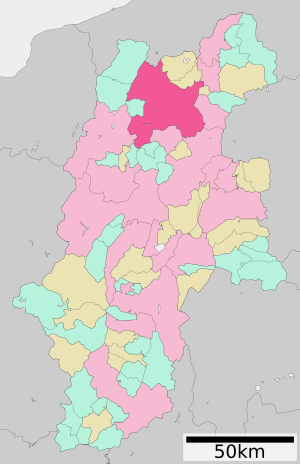 |
|||||||||||
| Country | Japan | ||||||||||
| Region | Chūbu (Kōshin'etsu) | ||||||||||
| Prefecture | Nagano | ||||||||||
| Area | |||||||||||
| • Total | 834.81 km2 (322.32 sq mi) | ||||||||||
| Population
(July 1, 2023)
|
|||||||||||
| • Total | 365,296 | ||||||||||
| • Density | 437.580/km2 (1,133.327/sq mi) | ||||||||||
| Time zone | UTC+9 (Japan Standard Time) | ||||||||||
| Phone number | 026-226-4911 | ||||||||||
| Address | 1613 Midori-chō, Nagano-shi, Nagano-ken 380-8512 | ||||||||||
| Climate | Cfa/Dfa | ||||||||||
|
|||||||||||
Nagano (長野市, Nagano-shi) is the capital and largest city of Nagano Prefecture in Japan. It's located in the Nagano Basin, a flat area surrounded by mountains in the central Chūbu region. Nagano is known as a "core city" of Japan. It is the highest prefectural capital in Japan, sitting at about 371 meters above sea level. The city is close to where the Chikuma River, Japan's longest and widest river, meets the Sai River. As of July 1, 2023, about 365,296 people live in Nagano. The city covers an area of about 834.81 square kilometers.
Contents
About Nagano City
Nagano City grew around Zenkō-ji, a famous Buddhist temple from the 7th century. This temple is considered a Japanese National Treasure. Zenkō-ji was built in its current spot in 642 AD, about two kilometers from where Nagano Station is today.
During the Sengoku Period (a time of civil war in Japan from 1467 to 1600), the area around Nagano was where the Battles of Kawanakajima took place between 1553 and 1564. Later, in the Edo period (1603-1868), Nagano became an important post station on the Hokkoku Kaidō highway. This highway connected Edo (which is now Tokyo) to the Sea of Japan coast. Nagano became the first modern town in Nagano Prefecture on April 1, 1897, after the Meiji Restoration.
Nagano City and some nearby towns hosted the 1998 Winter Olympics and 1998 Winter Paralympics. Today, Nagano is an important historical place and an industrial center. It's also a great place for tourists and a starting point to visit nearby attractions. These include onsen (hot springs), the famous snow monkeys in Yamanouchi, and world-class ski resorts like Hakuba, Shiga Kogen, and Nozawaonsen.
The 1998 Winter Olympics and Paralympics
Nagano, along with nearby places like Hakuba and Nozawaonsen, hosted the 1998 Winter Olympics from February 7 to February 22. The 1998 Winter Paralympics followed from March 5 to March 14. This was the third time Japan hosted the Olympic Games and the second time it hosted the Winter Olympic Games. The first Winter Games in Asia were held in Sapporo in 1972. As of 2019, Nagano was the southernmost city to host the Winter Olympics. To remember this event, the Nagano Olympic Commemorative Marathon is held every year.
A big improvement from the Games was a better transportation system. To make it easier to get to Nagano, a high-speed shinkansen (bullet train) line was built. The Nagano Shinkansen (now called the Hokuriku Shinkansen) opened five months before the Games. It carried 655,000 passengers during the Winter Olympics. Also, Nagano Station and Shinonoi Station were made bigger, and Imai Station was built near the Athletes' Village. New expressways, the Nagano Expressway and the Jōshin-etsu Expressway, were built in the Nagano area. Many other roads in Nagano Prefecture were also improved.
The Games also led to the building of several world-class sports venues. One example is M-Wave, which was Japan's first indoor 400m speed skating track that met international standards. It also has one of the largest hanging wooden roofs in the world. The Athletes' Village, built near the new Imai Station, was designed to become public housing after the Games. A Media Village was also built for reporters and now serves as private and government housing.
Nagano's Geography
Nagano is in the north-central part of Nagano Prefecture, in a flat area called the Nagano Basin. It's surrounded by mountains and is located near where the Chikuma River and the Sai River meet. Other important rivers in Nagano include the Susobana River and the Torii River, both starting in the Togakushi highlands. Parts of three national parks—Myōkō-Togakushi Renzan National Park, Jōshin'etsu-kōgen National Park, and Chūbu-Sangaku National Park—are located within Nagano City.
Today, the city of Nagano includes many different areas and former towns. These include Shinonoi, Matsushiro, Wakaho, Kawanakajima, and Togakushi.
Surrounding Mountains
Nagano is surrounded by many beautiful mountains.
- Mount Takatsuma, at 2,353 meters, is the highest point in Nagano City. It's part of the Togakushi mountain range and is one of Japan's 100 Famous Japanese Mountains. People sometimes call it Togakushi Fuji because of its pyramid shape. The lowest point in Nagano City is 327.4 meters above sea level in the Asano area of Toyono.
- Mount Iizuna, 1,917 meters high, is a popular place for skiing. The bobsleigh and luge track for the 1998 Winter Olympics, called the Spiral, is located here.
- Mount Togakushi, 1,904 meters high, is also within Nagano City.
- Mount Minakami, 659 meters high, is a lava dome in Matsushiro, Nagano City.
Climate in Nagano
Nagano has a climate that is mostly a hot-summer humid continental climate, but it also has some features of a humid subtropical climate. Because it's in a sheltered valley, it gets less rain than most other parts of Japan, except for Hokkaidō. The city gets a lot of snow in winter, about 2.57 meters from December to March. However, these cold months are not as cloudy as the coastal areas of Japan.
| Climate data for Nagano (1991−2020 normals, extremes 1889−present) | |||||||||||||
|---|---|---|---|---|---|---|---|---|---|---|---|---|---|
| Month | Jan | Feb | Mar | Apr | May | Jun | Jul | Aug | Sep | Oct | Nov | Dec | Year |
| Record high °C (°F) | 18.1 (64.6) |
22.5 (72.5) |
24.4 (75.9) |
30.8 (87.4) |
34.2 (93.6) |
35.6 (96.1) |
37.9 (100.2) |
38.7 (101.7) |
36.3 (97.3) |
32.2 (90.0) |
26.2 (79.2) |
22.0 (71.6) |
38.7 (101.7) |
| Mean daily maximum °C (°F) | 3.8 (38.8) |
5.3 (41.5) |
10.3 (50.5) |
17.4 (63.3) |
23.2 (73.8) |
26.1 (79.0) |
29.7 (85.5) |
31.1 (88.0) |
26.2 (79.2) |
19.7 (67.5) |
13.4 (56.1) |
6.9 (44.4) |
17.8 (64.0) |
| Daily mean °C (°F) | −0.4 (31.3) |
0.4 (32.7) |
4.3 (39.7) |
10.6 (51.1) |
16.4 (61.5) |
20.4 (68.7) |
24.3 (75.7) |
25.4 (77.7) |
21.0 (69.8) |
14.4 (57.9) |
7.9 (46.2) |
2.3 (36.1) |
12.3 (54.1) |
| Mean daily minimum °C (°F) | −3.9 (25.0) |
−3.7 (25.3) |
−0.5 (31.1) |
4.9 (40.8) |
10.9 (51.6) |
16.1 (61.0) |
20.5 (68.9) |
21.5 (70.7) |
17.2 (63.0) |
10.3 (50.5) |
3.4 (38.1) |
−1.5 (29.3) |
7.9 (46.2) |
| Record low °C (°F) | −17.0 (1.4) |
−16.4 (2.5) |
−14.6 (5.7) |
−6.5 (20.3) |
−1.8 (28.8) |
3.9 (39.0) |
10.2 (50.4) |
10.7 (51.3) |
5.5 (41.9) |
−1.9 (28.6) |
−11.4 (11.5) |
−15.2 (4.6) |
−17.0 (1.4) |
| Average precipitation mm (inches) | 54.6 (2.15) |
49.1 (1.93) |
60.1 (2.37) |
56.9 (2.24) |
69.3 (2.73) |
106.1 (4.18) |
137.7 (5.42) |
111.8 (4.40) |
125.5 (4.94) |
100.3 (3.95) |
44.4 (1.75) |
49.4 (1.94) |
965.1 (38.00) |
| Average snowfall cm (inches) | 63 (25) |
50 (20) |
17 (6.7) |
2 (0.8) |
0 (0) |
0 (0) |
0 (0) |
0 (0) |
0 (0) |
0 (0) |
1 (0.4) |
30 (12) |
163 (64) |
| Average precipitation days (≥ 0.5 mm) | 12.7 | 11.0 | 11.3 | 9.8 | 9.6 | 11.6 | 13.5 | 10.8 | 10.6 | 9.2 | 8.6 | 11.2 | 130.0 |
| Average relative humidity (%) | 79 | 74 | 68 | 61 | 63 | 71 | 75 | 73 | 74 | 75 | 76 | 79 | 72 |
| Mean monthly sunshine hours | 128.4 | 140.2 | 173.3 | 199.4 | 214.8 | 167.4 | 168.8 | 201.1 | 151.2 | 152.1 | 142.3 | 131.1 | 1,969.9 |
| Source: Japan Meteorological Agency | |||||||||||||
| Climate data for Shinshūshinmachi, Nagano (1991−2020 normals, extremes 1978−present) | |||||||||||||
|---|---|---|---|---|---|---|---|---|---|---|---|---|---|
| Month | Jan | Feb | Mar | Apr | May | Jun | Jul | Aug | Sep | Oct | Nov | Dec | Year |
| Record high °C (°F) | 15.3 (59.5) |
21.0 (69.8) |
25.8 (78.4) |
30.1 (86.2) |
34.6 (94.3) |
35.8 (96.4) |
36.6 (97.9) |
38.6 (101.5) |
35.3 (95.5) |
29.8 (85.6) |
24.4 (75.9) |
21.6 (70.9) |
38.6 (101.5) |
| Mean daily maximum °C (°F) | 3.6 (38.5) |
4.9 (40.8) |
9.9 (49.8) |
17.1 (62.8) |
22.8 (73.0) |
25.8 (78.4) |
29.2 (84.6) |
30.4 (86.7) |
25.4 (77.7) |
19.1 (66.4) |
13.2 (55.8) |
6.8 (44.2) |
17.3 (63.2) |
| Daily mean °C (°F) | −1.4 (29.5) |
−0.8 (30.6) |
3.1 (37.6) |
9.3 (48.7) |
15.1 (59.2) |
19.2 (66.6) |
22.9 (73.2) |
23.9 (75.0) |
19.5 (67.1) |
13.0 (55.4) |
6.6 (43.9) |
1.2 (34.2) |
11.0 (51.8) |
| Mean daily minimum °C (°F) | −5.5 (22.1) |
−5.4 (22.3) |
−2.1 (28.2) |
2.8 (37.0) |
8.5 (47.3) |
14.1 (57.4) |
18.8 (65.8) |
19.5 (67.1) |
15.5 (59.9) |
8.8 (47.8) |
2.0 (35.6) |
−2.7 (27.1) |
6.2 (43.1) |
| Record low °C (°F) | −15.3 (4.5) |
−13.4 (7.9) |
−10.3 (13.5) |
−5.8 (21.6) |
−1.5 (29.3) |
4.1 (39.4) |
11.6 (52.9) |
11.2 (52.2) |
4.3 (39.7) |
−0.6 (30.9) |
−4.6 (23.7) |
−12.3 (9.9) |
−15.3 (4.5) |
| Average precipitation mm (inches) | 56.2 (2.21) |
52.4 (2.06) |
76.3 (3.00) |
76.4 (3.01) |
88.7 (3.49) |
123.2 (4.85) |
146.5 (5.77) |
111.2 (4.38) |
148.7 (5.85) |
122.8 (4.83) |
53.8 (2.12) |
51.3 (2.02) |
1,107.4 (43.60) |
| Average precipitation days (≥ 1.0 mm) | 10.4 | 8.8 | 10.8 | 9.4 | 9.5 | 11.0 | 13.4 | 9.9 | 10.4 | 9.1 | 7.6 | 10.3 | 120.6 |
| Mean monthly sunshine hours | 123.2 | 139.5 | 171.6 | 200.4 | 209.3 | 158.7 | 158.1 | 192.1 | 137.1 | 145.0 | 139.5 | 124.8 | 1,899.1 |
| Source: Japan Meteorological Agency | |||||||||||||
Nagano's Population
The population of Nagano City has gone down by about 10,000 people since the mid-1990s. As of April 1, 2019, the city had 376,080 residents living in 160,625 households.
Historical Population Changes
| Historical population | ||
|---|---|---|
| Year | Pop. | ±% |
| 1920 | 212,182 | — |
| 1925 | 222,141 | +4.7% |
| 1930 | 234,503 | +5.6% |
| 1935 | 239,513 | +2.1% |
| 1940 | 241,716 | +0.9% |
| 1945 | 295,090 | +22.1% |
| 1950 | 300,756 | +1.9% |
| 1955 | 303,435 | +0.9% |
| 1960 | 303,458 | +0.0% |
| 1965 | 310,399 | +2.3% |
| 1970 | 322,825 | +4.0% |
| 1975 | 342,120 | +6.0% |
| 1980 | 358,173 | +4.7% |
| 1985 | 369,023 | +3.0% |
| 1990 | 377,261 | +2.2% |
| 1995 | 387,359 | +2.7% |
| 2000 | 387,911 | +0.1% |
| 2005 | 386,572 | −0.3% |
| 2010 | 381,511 | −1.3% |
| 2015 | 377,598 | −1.0% |
| 2020 | 372,760 | −1.3% |
Foreign Residents in Nagano
The table below shows the number of foreign residents in Nagano City since 2014.
| Year | Total | Chinese | Korean | Filipino | Vietnamese | Thai | Other |
|---|---|---|---|---|---|---|---|
| 2014 | 3,394 | 1,619 | 587 | 301 | 136 | 219 | 532 |
| 2015 | 3,475 | 1,612 | 571 | 320 | 195 | 226 | 551 |
| 2016 | 3,475 | 1,595 | 542 | 319 | 248 | 239 | 552 |
| 2017 | 3,576 | 1,576 | 536 | 336 | 314 | 241 | 573 |
| 2018 | 3,715 | 1,563 | 557 | 344 | 392 | 242 | 617 |
Neighboring Towns and Cities
Nagano City is surrounded by many other interesting towns and cities.
- Shinano is north of Nagano, known for Lake Nojiri.
- Nakano grew a lot after the 1998 Winter Olympics.
- Suzaka was once a castle town and is now known for electronics, apples, and grapes.
- Obuse is a historical tourist town with a Hokusai museum.
- Ueda is south of Nagano and has the ruins of Ueda Castle.
- Chikuma has ancient burial tombs and was important for travelers to Zenkō-ji.
- Ōmachi is surrounded by the tall Hida Mountains, also called the Japanese Northern Alps.
- Hakuba is a famous international ski resort in the northern Japan Alps. It was a key location for the 1998 Winter Olympics.
Nagano's History
Early Times
Nagano is in what was once Shinano Province. It started as a temple town around the famous Zenkō-ji temple, which was moved to this spot in 642 AD. In the southern part of Nagano City, there are over 500 ancient burial mounds at Ōmuro Kofun. These mounds date from the 5th to 8th centuries and are a National historic site.
Medieval Period
During the Sengoku period (a time of civil war), the area was a battleground between the Uesugi clan and the Takeda clan. Several Battles of Kawanakajima were fought nearby between famous leaders Uesugi Kenshin and Takeda Shingen.
Edo Period and Later
In the Edo period (1603-1868), much of the area was controlled by the Sanada clan from Matsushiro Domain. The area faced challenges like floods in 1742 and a big earthquake in 1847. Nagano also became an important post station on the Hokkoku Kaidō highway.
After the Meiji Restoration, the modern town of Nagano was created on April 1, 1889. It became a city on April 1, 1897. During World War II, a large underground bunker complex called the Matsushiro Underground Imperial Headquarters was started in 1944. It was meant to be a secret hideout for the Japanese government, but construction stopped when the war ended in 1945. Nagano was the first city founded in Nagano Prefecture and the 43rd city in Japan. It hosted the 1998 Winter Olympics, 1998 Winter Paralympics, and the 2005 Special Olympics World Winter Games.
Modern City Growth
Nagano City has grown over time by adding nearby towns and villages.
- On July 1, 1923, it added Yoshida, Sarita, Miwa, and Komaki.
- On April 1, 1954, it expanded again by annexing Asahi, Furusato, Yanagihara, and other villages.
- In 1959, a flood from the Chikuma River caused damage and loss of life.
- On October 16, 1966, Nagano expanded further by adding towns like Kawanakajima and Matsushiro.
- In 1985, an earthquake in Matsushiro caused landslides and damage.
- In 1999, Nagano was named a "core city" of Japan.
- On January 1, 2005, Nagano absorbed Toyono, Togakushi, Kinasa, and Ōoka.
- On January 1, 2010, it absorbed Shinshūshinmachi and Nakajō.
Public Facilities
Libraries in Nagano
Nagano has several libraries for public use:
- Nagano City Library: About 1.5 kilometers north of Nagano Station.
- Nagano City Nambu Library: 400 meters south of Shinonoi Station.
- Nagano Prefectural Library: 800 meters south of Nagano Station.
- The University of Nagano public library: 700 meters north of Hongō Station.
- Nagano City Lifelong Learning Center: 350 meters west of Shiyakushomae Station.
International Connections
Sister Cities Around the World
Nagano has special relationships with cities in other countries:
| City | Country | State | since |
|---|---|---|---|
| Clearwater | Florida | March 1959 | |
| Shijiazhuang | Hebei | April 1981 | |
| Ecatepec (Ciudad Azteca) | Mexico | March 2004 |
Partnership Cities in Japan
Nagano also has partnerships with other cities within Japan:
| City | Prefecture | region | since |
|---|---|---|---|
| Jōetsu | Chūbu region | October 14, 2005 | |
| Kanazawa | Chūbu region | February 15, 2007 | |
| Kōfu | Chūbu region | September 1, 2007 | |
| Shizuoka | Chūbu region | July 1, 2010 | |
| Toyama | Chūbu region | October 2, 2012 | |
| Fukui | Chūbu region | August 9, 2013 |
Nagano's Economy
In 2016, the total value of goods and services produced in Nagano City was about 4.4 trillion yen (around US$40.5 billion). The biggest parts of Nagano's economy are:
- Wholesale and retail (buying and selling goods): 41.8%
- Healthcare and welfare: 25.9%
- Manufacturing (making products): 13.7%
In 2016, 183,710 people worked in Nagano City. Many worked in wholesale or retail (21.1%), healthcare and welfare (14%), and manufacturing (11.6%). Other important jobs were in hotels and restaurants (9%) and construction (7.9%). Only a small number of people (1.1%) worked in farming and forestry.
Major Companies in Nagano City
Many important companies have their main offices or factories in Nagano City. Some of these include:
- Hachijuni Bank (financial services)
- Hokto (agriculture)
- Kitano Construction (construction)
- Marukome (food, famous for miso)
- Nagano Electric Railway (transportation)
- Ogasaka Ski (ski manufacturer)
- Fujitsu (electronics factory)
- Japan Post (training center)
- Nishina (hydraulic equipment for vehicles)
- Ricoh (electronics)
Mass Media
Local Newspapers
- Shinano Mainichi newspaper
- Nagano Shinmin newspaper
Television Stations
- NHK Nagano
- Shin-etsu Broadcasting (SBC)
- Nagano Broadcasting Systems (NBS)
- TV Shinshu
- Asahi Broadcasting Nagano (ABN)
Education in Nagano
Nagano is home to several universities and colleges, both public and private.
Universities and Colleges
- Shinshu University: A national university with campuses in Nagano and other cities.
- The University of Nagano: A four-year university that opened in 2018. All first-year students live in a dorm, and all second-year students study abroad.
- National Institute of Technology, Nagano College: An engineering college with five departments.
- Nagano Prefectural Agricultural College: A two-year college for practical agriculture.
- Seisen Jogakuin College: A private Catholic women's college.
- Nagano Women's Junior College: A private women's junior college.
- Nagano University of Health and Medicine: Opened in 2015, focusing on nursing and health science.
High Schools
Nagano has many high schools, including public and private ones. Some are general high schools, while others focus on specific skills like technology or business.
Primary and Secondary Education
The city government runs 55 public elementary schools and 24 public middle schools. There is also one public middle school run by the national government and four private middle schools. For high school, there are 12 public high schools run by the Nagano Prefectural Board of Education, and five private high schools. Nagano also has four special education schools.
Transportation in Nagano
Air Travel
The closest airport to Nagano City is Matsumoto Airport. You can get there by a 70-minute express bus ride from Nagano City.
Train Travel
Nagano Station is the main train hub in the city. The 1998 Winter Olympics brought big changes to the train system. Nagano Station and Shinonoi Station were made larger. A new station, Imai Station, was built near the Athletes' Village. The Hokuriku Shinkansen (originally called the Nagano Shinkansen) opened in 1997 before the Games. This bullet train connects Nagano to Tokyo, cutting travel time between the two cities to just 79 minutes. Nagano Station connects JR East trains, Shinano Railway trains, and Nagano Electric Railway trains.
High-Speed Rail
 East Japan Railway Company (JR East)
East Japan Railway Company (JR East)
- Hokuriku Shinkansen: - Nagano -
Local Train Lines
 East Japan Railway Company (JR East)
East Japan Railway Company (JR East)
- Shin'etsu Main Line: - Shinonoi - Imai - Kawanakajima - Amori - Nagano -
- Shinonoi Line: - Inariyama - Shinonoi -
- Iiyama Line: - Toyono - Shinano-Asano - Tategahana -
- Kita-Shinano Line: Nagano - Kita-Nagano - Sansai - Toyono -
- Shinano Railway Line: - Shinonoi -
- Nagano Line: Nagano - Shiyakushomae - Gondō - Zenkōjishita - Hongō - Kirihara - Shinano-Yoshida - Asahi - Fuzokuchūgakumae - Yanagihara -
Bus Services
Buses from Kawanakajima Bus and Nagano Dentetsu Bus Co. serve the city and nearby areas. They leave from Nagano Station and the Nagano Bus Terminal. Local buses from Alpico Kōtsū also run from an office near Nagano Station. Long-distance highway buses leave from the East Exit of Nagano Station, including a daily bus to Narita International Airport.
The Gururin-go is a special bus that travels in a circle around the central district. It goes from Nagano Station to Zenkō-ji, passing the Nagano Prefectural Office and the Nagano Bus Terminal. The fare is 150 yen, no matter how far you ride.
Roads
Expressways
 Jōshin-etsu Expressway
Jōshin-etsu Expressway Nagano Expressway
Nagano Expressway
National Routes
 National Route 18
National Route 18 National Route 19
National Route 19 National Route 117
National Route 117 National Route 403
National Route 403 National Route 406
National Route 406
Fun Things to Do in Nagano
Nagano is surrounded by mountains, perfect for hiking, camping, and cycling. The city also has many important cultural sites: 46 national cultural assets, 55 prefectural cultural assets, and 298 city cultural assets.
Temples and Shrines
- Zenkō-ji: A very old Buddhist temple and a popular pilgrimage spot.
- Togakushi Shrine: A group of five Shinto shrines in the mountains above Nagano. The path to the top shrine goes through more than 300 tall Cryptomeria trees.
- Saikou-ji: A Buddhist temple about 1 kilometer west of Zenkō-ji.
- Miwa Shrine: Likely started in the 9th century, located near Hongō Station.
- Yushimatenmangu Shrine: A branch of a famous shrine in Tokyo, located in Wakaho.
Historical Places to Visit
- Monzenmachi: The area around the gate of Zenkō-ji. It has old buildings, shops, and restaurants.
- Zenkoji Nakamise-dori Street: A stone-paved street with many local shops.
- Daimon-cho: Features old merchant houses from the Taishō era (1912-1926).
- Patio Daimon: A shopping area opened in 2017, made by renovating old warehouses.
- Matsushiro Castle: This castle and its surrounding town have many preserved samurai homes, temples, and gardens from the Edo period.
- Chokokuji Temple: The family temple of the Sanada clan, with the tomb of Sanada Nobuyuki. It's an important cultural property.
- The Bunbu School: A National Historic Site next to Matsushiro Castle, where samurai studied.
- The Matsushiro Clan Sanada Jumangoku Festival: Held in mid-October, it's a reenactment of a 16th-century procession.
- The former home of the Yokota family: A middle-class samurai home with a traditional thatched roof and garden.
- The Sakuma Zozan Shrine: Dedicated to Sakuma Zozan, a 19th-century scholar and scientist who wanted Japan to open up to the world.
- Matsushiro Underground Imperial Headquarters: A large underground bunker complex built during World War II.
- Kawanakajima Battlefields: Located in southern Nagano City, this is where the famous 16th-century battles between Takeda Shingen and Uesugi Kenshin took place.
- The Nagano City Museum is located here.
- Tenku-ji Temple: A temple where prayers are offered for those who died in the Kawanakajima battles. It has a 5-meter statue of King Enma, the Buddhist ruler of the underworld.
Culture in Nagano
Events and Festivals
- Nagano Tomyo Festival: A light and lantern festival held every February to celebrate the 1998 Winter Olympics.
- Nagano Olympic Commemorative Marathon: A marathon held in mid-April.
- Hanami: Cherry blossom viewing in Joyama Park, usually from mid to late April.
- Nagano Floral Festa Zenkoji Temple: A flower and flower art event in early May.
- Buckwheat blossom viewing: From mid-July to mid-September in Togakushi.
- Kijo ("Ogress") Momoji Festival: Held in mid-October in Iizuna, celebrating nature.
- Togakushi Soba Festival: Held in early November.
- Yoi Ebisu and Ebisuko Fireworks display: Dedicated to the god of fortune, held in late November.
Sports in Nagano
- Nagano Sports Park: A large sports area with the Aqua Wing Arena, Nagano Athletic Stadium, tennis courts, a baseball stadium, and a gym.
- AC Nagano Parceiro: A men's professional soccer club that plays in the J3 League.
- AC Nagano Parceiro Ladies: A women's professional soccer team that plays in the top division of women's football in Japan.
- Shinshu Brave Warriors: A professional basketball team in Japan's B.League.
- Shinano Grandserows: A minor baseball team that plays at the Nagano Olympic Stadium.
- Boaluz Nagano: A futsal team that plays at the White Ring (arena).
- Nagano City Gliding Field: Opened in 1974, located along the Chikuma River.
| Club | Sport | League | Venue | Established |
|---|---|---|---|---|
| AC Nagano Parceiro | Soccer | J.League | Minami Nagano Sports Park Stadium | 1990 |
| AC Nagano Parceiro Ladies | Soccer | WE.League | Minami Nagano Sports Park Stadium | 2000 |
| Shinano Grandserows | Baseball | BC.League | Nagano Olympic Stadium | 2006 |
| Boaluz Nagano | Futsal | F.League | White Ring | 2011 |
| Shinshu Brave Warriors | Basketball | B.League | White Ring | 2011 |
Famous People from Nagano
- Yoko Aki: Songwriter, actress, novelist
- Joe Hisaishi: Composer
- Takeru Kobayashi: Competitive eater
- Hiro Mashima: Manga artist
- Emi Nitta: Voice actress
- Yuto Adachi: Member of K-pop boy band Pentagon
Images for kids
- Nagano (city)
-
Japanese macaque at Jigokudani hotspring
See also
 In Spanish: Nagano para niños
In Spanish: Nagano para niños












